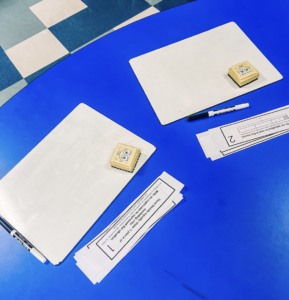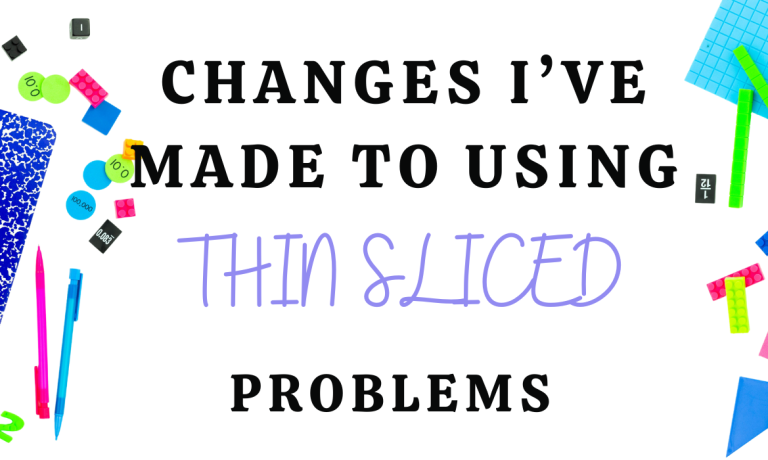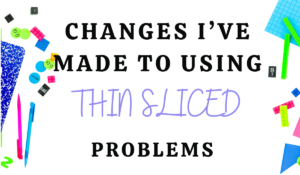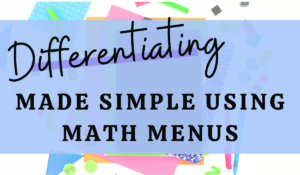This is my 5th year using thin sliced problems in math class. Let me start by saying it is one of my favorite things I have done for my math class. I have changed a few things over the years. Not everything is going to work for every class. But for each group of students, I find what works best when it comes to thin sliced problems. Keep reading to learn about the changes I’ve made to using thin sliced problems in math class.
What Are Thin Sliced Problems?
Using thin sliced math problems is when you provide students with one problem at a time, and each problem increases in difficulty, but only slightly.
What Do They Look Like?
They are quite literally thin sliced pieces of paper in my classroom. There is one problem per paper. The papers also have numbers on them (1, 2, 3, etc.) so students know which problem to do first, second, etc. Click this link to download a free version of the template that I use when I create my thin sliced problems: Thin Sliced Problem Example
How Often Do You Use Thin Sliced Problems?
This is one of the biggest changes I have made this year. I follow a math curriculum which requires me to teach whole group. So I do the lesson, and then I have about 30 minutes for Math Menu time. (If you want to learn more about Math Menus, click here.) Because of that, I am not meeting with every student every day. So instead of having one set of thin sliced problems per day, I have one set per week.
My student groups are mixed ability, but I pull students to meet with them in groups by their ability. I have three different levels of students. If you want to read more about how I do this, click here. My highest group is the first group to do the thin sliced problems, usually on Tuesday. This is because they would have the least amount of direct instruction so far with the content, but they are the most likely to be able to use what they have learned to propel themselves through and make connections while doing the thin sliced problems. Then my middle group completes the thin sliced problems on Wednesday, and my lowest group completes them on Thursday, so they have had the most exposure to the content by then.
Why Do You Use Thin Sliced Problems?
My students benefited so much from using thin sliced problems over the past few years. Here are some of the reasons why I loved using them in my small group:
-They solved them on mini white boards. I don’t know what it is about white boards, but students are more likely to try when they know are able to instantly erase a mistake.
– It is self-checking. The answers are on the back, so when students solve a problem on their white board they turn the problem over and check their answer. If they got it correct they move on to the next problem. If they made a mistake they look at the work and try to figure out where they made their mistake.
-Students are able to move at their own pace. If they stay on problem 1 the whole time, that is fine! Problem 1 is meeting the objective. If they move on to problem 2, that is also okay! If they finish all of them, they have gone above and beyond the objective, which is also okay! This meets every students needs without an intense amount of differentiation.
-It decreases the chances of students becoming overwhelmed wit the number of problems they need to do. Students can get anxious when they are given a worksheet with 8+ problems on them. With thin slicing, they are only focusing on one problem.
-Students worked for a set amount of time, not until they finished a certain problem. This way, they are working until it is time to go back, and if they spend the whole time on one problem, that is okay! However, this rarely happens when I am able to meet with such small groups and support them if needed. They are allowed to go back to their tables if they finish all of the problems before the time is up.
-It allows me to see exactly what a student needs. Each problem increases in difficulty (but only slightly) so it is easy to pinpoint exactly what a student is struggling with if they get stuck on a certain problem or get a certain problem wrong. Click this link to download some free templates of the tracker I use when I am taking notes in my small group about the problems they are completing: Small Group Tracking Templates
How Do You Organize It?
This is another thing I have changed. I used to put them in a bin, which worked for a lot of groups. But this year, because I am pulling smaller groups (only 4 students at a time at my table), I simply put the stack of problems in front of each student. I was worried that students would rush to finish because they knew how many problems there are. But having that trust and transparency that they don’t have to finish all of them, or they can ask for help, has really made this worry non-existent.

What If Students Need More Support?
This is why I love small groups. This year, I never have more than 4 kids with me at a time. I am able to take notes, but also am able to easily jump in and ask probing questions to see where they are stuck. Then support is given when needed. I also make manipualtives a normal part of my classroom. We have decimal disks, fraction bars, and so much more available, and using them is not seen as something bad. It is just a tool, like a pencil, that you might need.
If you are a 5th grade teacher, you are in luck! I created TWO options that include over a years worth of 5th grade math thin sliced problems:
Option 1: Mini-Course that includes growing bundle of fully editable thin sliced problems, trackers, and videos to help you!
Option 2: Growing bundle of fully editable thin sliced problems and trackers
I have loved using thin sliced problems for the past 5 years. But these changes I’ve made to using thin sliced problems in math class this year have made it the best possible experience for both myself and my students.









4 thoughts on “Changes I’ve Made to Using Thin Sliced Problems”
Do you have any samples of your thin slicing problems or products for sale? My district does not have a formal curriculum to draw problems from.
I actually just created thin sliced problems for 5th grade!
How do you come up with your problems? Do you create differentiated sets of sliced questions based on their ability or does everyone have the same set of questions?
I create one set of problems. They go from easiest to hardest, so students get to whatever problems they can. It is like built in differentiation!